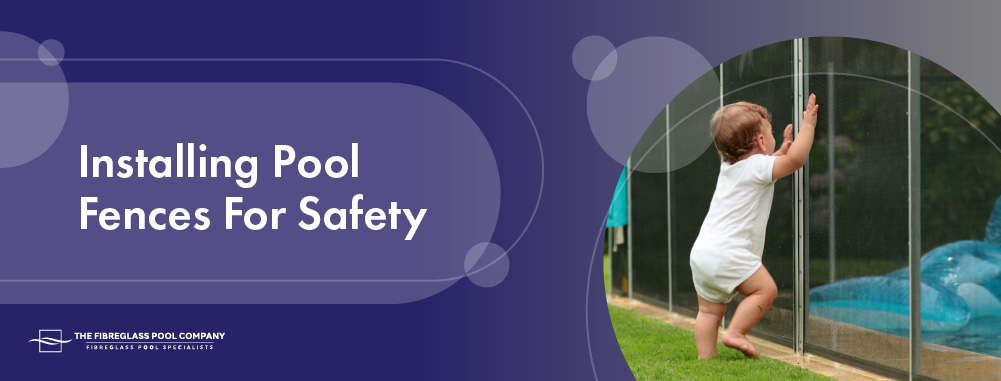Owning a pool can be a delightful luxury, especially during the sweltering summer months. For families, it’s a source of joy, exercise, and bonding. However, with this luxury comes great responsibility, particularly when it comes to safety. Pool-related accidents are a concerning reality, and the best way to prevent them is by installing a reliable pool fence. In this blog post, we’ll explore everything you need to know about pool fences, from their importance to the different types available, and how to install and maintain them for optimal safety.

Why Pool Safety Is Paramount
When it comes to ensuring the safety of your loved ones, especially children, around the pool, there’s no room for compromise. According to the World Health Organization, drowning is one of the leading causes of accidental death globally, with children being particularly vulnerable. A lapse in supervision, even for a moment, can lead to tragic outcomes.
Having a pool fence acts as a crucial barrier, significantly reducing the risk of accidental drownings. It provides a physical barrier that prevents unsupervised access, giving parents and guardians peace of mind. But beyond the statistics, it’s about creating a safe environment where families can enjoy their pool without constant fear of mishaps.
In this post, we’ll guide you through the various aspects of pool fences, helping you make an informed decision that best suits your needs.
Types of Pool Fences Available
Choosing the right pool fence is all about balancing aesthetics, functionality, and safety. Here are the main types of pool fences you might consider:
Traditional Barriers
Traditional pool fences are typically made from materials like wood, aluminium, or wrought iron. These fences are sturdy and offer long-lasting protection. They can be designed to complement the aesthetic of your home and garden, providing a secure barrier while enhancing your outdoor space.
Pros:
Durability – Traditional barriers are robust and can withstand harsh weather conditions.
Customisable – You can paint or design them to fit your landscape.
Permanent Solution – Once installed, they require minimal adjustments.
Cons:
Cost – They can be more expensive compared to other options.
Installation – Professional installation is often needed.
Maintenance – Regular upkeep is necessary to prevent rust or wear.
Mesh Fences
Mesh pool fences are a popular choice for families with young children. They are made from a strong, weather-resistant fabric that provides a transparent barrier around your pool area. They’re also removable, offering flexibility for homeowners.
Pros:
Visibility – Allows a clear view of the pool area.
Removable – Easy to take down when not needed.
Child-resistant – Typically designed with self-closing and self-latching gates.
Cons:
Less Durable – May not last as long as traditional barriers.
Appearance – Some might find them less aesthetically pleasing.
Installation – While manageable, it can be tricky without professional help.
Glass Fences
For those who prefer a modern, sleek look, glass pool fences are an ideal option. Made from toughened safety glass, these fences provide a barrier without obstructing the view of your pool.
Pros:
Aesthetics – Minimalist design that doesn’t obstruct views.
Easy Maintenance – Glass panels are easy to clean.
Safety – High-strength glass offers robust protection.
Cons:
Cost – One of the more expensive fencing options.
Installation – Requires professional installation.
Maintenance – Requires regular cleaning to keep it spotless.

Installation Process for Each Type of Pool Fence
Understanding how to install each type of pool fence is crucial. Here’s a step-by-step guide for each:
Installing Traditional Barriers
Step 1:
Measure the perimeter of your pool area and decide on the fence height based on local regulations. Purchase the necessary materials, including posts, panels, screws, and cement.
Step 2:
Mark the post locations around the pool using stakes and string. Ensure the spacing between posts is consistent.
Step 3:
Dig holes for the posts, making sure they are deep enough to provide stability. Insert posts and fill with cement to secure them.
Step 4:
Attach the panels to the posts using screws. Ensure the gate is self-closing and self-latching to comply with safety standards.
Installing Mesh Fences
Step 1:
Measure the area around your pool and mark where the fence posts will go. Purchase a mesh fence kit that includes the fabric, poles, and gate.
Step 2:
Drill holes for the poles using a post hole digger. The holes should be deep enough to ensure stability.
Step 3:
Insert the poles into the holes and secure them, making sure they are level. Attach the mesh fabric to the poles, ensuring it is taut and secure.
Step 4:
Install the self-closing and self-latching gate according to the manufacturer’s instructions. Double-check that the fence height and gate meet local safety regulations.
Installing Glass Fences
Step 1:
Start by measuring the pool area and purchasing the necessary glass panels and posts. Ensure the glass is toughened safety glass.
Step 2:
Mark the post locations and drill holes for the anchors. Install the anchors and secure the posts to them.
Step 3:
Carefully place the glass panels between the posts, ensuring they are level and secure. Use setting blocks and clamps to hold them in place.
Step 4:
Install the gate, ensuring it is self-closing and self-latching. Double-check all panels and gate for stability and compliance with safety standards.

Maintaining Pool Fences for Ongoing Safety
Maintenance is key to ensuring your pool fence remains a reliable safety feature. Here are some tips:
Regular Inspections
Conduct regular inspections of your pool fence to identify any potential issues. Look for signs of wear, rust, or damage that could compromise its integrity. Ensure that the gate is functioning correctly and that the latches are secure.
Cleaning
Each type of fence requires specific cleaning methods. For traditional barriers, use a mild detergent and water to remove dirt and grime. Mesh fences can be cleaned with a gentle brush and soapy water. Glass fences should be cleaned with a glass cleaner to keep them looking pristine.
Repairs and Upgrades
Address any repairs immediately to maintain the fence’s effectiveness. Replace damaged panels, tighten loose screws, and repair any rust spots. Consider upgrading your fence if it no longer meets safety standards or if you want to improve its appearance.
Conclusion
Installing a pool fence is a critical step in ensuring the safety of your family and friends. By understanding the different types of fences available and the installation process, you can make an informed decision that best suits your needs. Regular maintenance will ensure your pool fence remains effective and compliant with safety regulations.
Owning a pool can be a delightful luxury, especially during the sweltering summer months. For families, it’s a source of joy, exercise, and bonding. However, with this luxury comes great responsibility, particularly when it comes to safety. Pool-related accidents are a concerning reality, and the best way to prevent them is by installing a reliable pool fence. In this blog post, we’ll explore everything you need to know about pool fences, from their importance to the different types available, and how to install and maintain them for optimal safety.

Why Pool Safety Is Paramount
When it comes to ensuring the safety of your loved ones, especially children, around the pool, there’s no room for compromise. According to the World Health Organization, drowning is one of the leading causes of accidental death globally, with children being particularly vulnerable. A lapse in supervision, even for a moment, can lead to tragic outcomes.
Having a pool fence acts as a crucial barrier, significantly reducing the risk of accidental drownings. It provides a physical barrier that prevents unsupervised access, giving parents and guardians peace of mind. But beyond the statistics, it’s about creating a safe environment where families can enjoy their pool without constant fear of mishaps.
In this post, we’ll guide you through the various aspects of pool fences, helping you make an informed decision that best suits your needs.
Types of Pool Fences Available
Choosing the right pool fence is all about balancing aesthetics, functionality, and safety. Here are the main types of pool fences you might consider:
Traditional Barriers
Traditional pool fences are typically made from materials like wood, aluminium, or wrought iron. These fences are sturdy and offer long-lasting protection. They can be designed to complement the aesthetic of your home and garden, providing a secure barrier while enhancing your outdoor space.
Pros:
Durability – Traditional barriers are robust and can withstand harsh weather conditions.
Customisable – You can paint or design them to fit your landscape.
Permanent Solution – Once installed, they require minimal adjustments.
Cons:
Cost – They can be more expensive compared to other options.
Installation – Professional installation is often needed.
Maintenance – Regular upkeep is necessary to prevent rust or wear.
Mesh Fences
Mesh pool fences are a popular choice for families with young children. They are made from a strong, weather-resistant fabric that provides a transparent barrier around your pool area. They’re also removable, offering flexibility for homeowners.
Pros:
Visibility – Allows a clear view of the pool area.
Removable – Easy to take down when not needed.
Child-resistant – Typically designed with self-closing and self-latching gates.
Cons:
Less Durable – May not last as long as traditional barriers.
Appearance – Some might find them less aesthetically pleasing.
Installation – While manageable, it can be tricky without professional help.
Glass Fences
For those who prefer a modern, sleek look, glass pool fences are an ideal option. Made from toughened safety glass, these fences provide a barrier without obstructing the view of your pool.
Pros:
Aesthetics – Minimalist design that doesn’t obstruct views.
Easy Maintenance – Glass panels are easy to clean.
Safety – High-strength glass offers robust protection.
Cons:
Cost – One of the more expensive fencing options.
Installation – Requires professional installation.
Maintenance – Requires regular cleaning to keep it spotless.

Installation Process for Each Type of Pool Fence
Understanding how to install each type of pool fence is crucial. Here’s a step-by-step guide for each:
Installing Traditional Barriers
Step 1:
Measure the perimeter of your pool area and decide on the fence height based on local regulations. Purchase the necessary materials, including posts, panels, screws, and cement.
Step 2:
Mark the post locations around the pool using stakes and string. Ensure the spacing between posts is consistent.
Step 3:
Dig holes for the posts, making sure they are deep enough to provide stability. Insert posts and fill with cement to secure them.
Step 4:
Attach the panels to the posts using screws. Ensure the gate is self-closing and self-latching to comply with safety standards.
Installing Mesh Fences
Step 1:
Measure the area around your pool and mark where the fence posts will go. Purchase a mesh fence kit that includes the fabric, poles, and gate.
Step 2:
Drill holes for the poles using a post hole digger. The holes should be deep enough to ensure stability.
Step 3:
Insert the poles into the holes and secure them, making sure they are level. Attach the mesh fabric to the poles, ensuring it is taut and secure.
Step 4:
Install the self-closing and self-latching gate according to the manufacturer’s instructions. Double-check that the fence height and gate meet local safety regulations.
Installing Glass Fences
Step 1:
Start by measuring the pool area and purchasing the necessary glass panels and posts. Ensure the glass is toughened safety glass.
Step 2:
Mark the post locations and drill holes for the anchors. Install the anchors and secure the posts to them.
Step 3:
Carefully place the glass panels between the posts, ensuring they are level and secure. Use setting blocks and clamps to hold them in place.
Step 4:
Install the gate, ensuring it is self-closing and self-latching. Double-check all panels and gate for stability and compliance with safety standards.

Maintaining Pool Fences for Ongoing Safety
Maintenance is key to ensuring your pool fence remains a reliable safety feature. Here are some tips:
Regular Inspections
Conduct regular inspections of your pool fence to identify any potential issues. Look for signs of wear, rust, or damage that could compromise its integrity. Ensure that the gate is functioning correctly and that the latches are secure.
Cleaning
Each type of fence requires specific cleaning methods. For traditional barriers, use a mild detergent and water to remove dirt and grime. Mesh fences can be cleaned with a gentle brush and soapy water. Glass fences should be cleaned with a glass cleaner to keep them looking pristine.
Repairs and Upgrades
Address any repairs immediately to maintain the fence’s effectiveness. Replace damaged panels, tighten loose screws, and repair any rust spots. Consider upgrading your fence if it no longer meets safety standards or if you want to improve its appearance.
Conclusion
Installing a pool fence is a critical step in ensuring the safety of your family and friends. By understanding the different types of fences available and the installation process, you can make an informed decision that best suits your needs. Regular maintenance will ensure your pool fence remains effective and compliant with safety regulations.


